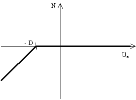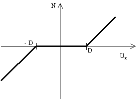Gap
There are various connection and support conditions used in a real structure. It may happen that a 1D member is not attached rigidly to the structure but "starts its action" only after some initial change of its length. The behaviour of such a beam is defined by the absolute value of the initial "slip". The beam then member starts to bear the load only after its elongation or shortening reaches the input value. There are three options available:
|
no tension Modelling e.g. the instant when a 1D member bears against a support. |
|
|
no compression Modelling e.g. a free rope. |
|
|
free in both directions E.g. a scaffold pipe. |
The algorithm applied has been designed for large structures. All 1D members are tested and processed simultaneously in every iteration step. The procedure is iterative and converges to the accurate solution. 1D members inserted into the model may be again eliminated in a next step if their deformation gets under the input value if initial displacement ("slip"). The convergence speed is high and does not depend on the number of 1D members. Eight to ten iteration steps should be sufficient for an arbitrary structure.
When inserted into the model, a 1D member with this type of nonlinearity is marked by the following symbol (remember that in order to see the symbol, view parameters must be adjusted to show model data).
Parameters
|
Type |
One of three types can be selected: (i) press only, (ii) tension only, (iii) both directions. See the diagrams above. |
|
Displacement |
Specifies the value of the initial "slip" before the 1D member becomes active. |
|
Position |
Specifies whether the "slipping" is allowed at the beginning or end of the 1D member. |




